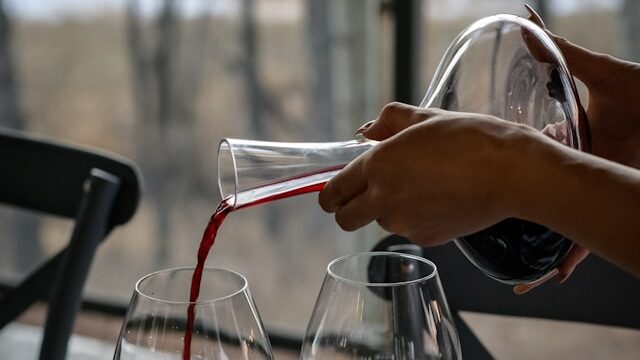Table of Contents
Have you ever wondered why some folks pour their wine into another container before serving it? That’s a wine decanter at work! Wine decanters serve an important purpose: they help the wine breathe. When you pour a bottle of wine into a decanter, you’re giving it a chance to mingle with the air. This can soften the flavors and release aromas that make the wine taste even better. Plus, if there’s any sediment in the bottle, decanting keeps it out of your glass of wine.
Now, you might have seen fancy wine aerators or even a wine decanter tower. These gadgets can speed up the aeration process or add a bit of style to your wine service. But whether it’s a simple glass vessel or a high-tech tool, the goal is the same: to make your wine-drinking experience as enjoyable as possible. Have you tried using one yet? How did it change the taste of your wine?
3 Key takeaways From the Topic
First, decanting helps wine unlock its full flavor potential by letting it breathe. Second, not all wines need the same amount of time in a decanter—some just need a quick swirl, while others benefit from a longer rest. Third, while some wines may not need decanting, for those that do, it can turn a good glass of wine into a great one.

The Essence of Wine Decanting
At its heart, the act of wine decanting is about letting the wine breathe. Have you noticed how a wine’s taste can change the longer it’s in your glass? That’s the wine breathing.
Aeration’s Role in Enhancing Wine Flavors
Think of aeration as a mini workout for your wine. When wine gets that rush of fresh air, it starts to express itself more fully. Those hidden notes and subtle flavors? They come to life! Especially for reds, a little bit of air can make a big difference. Wine aerators are like personal trainers for your bottle of wine, making sure each glass of wine is at its best. Have you ever used an aerator and been surprised by how much better the wine tasted?
Optimal Decanting Duration
But how long should we let our wine sit in a decanter? Well, it turns out that for most bottles of wine we enjoy right away, a short decanting time is just fine. But those special bottles of wine that have been waiting for a special occasion? They benefit from decanting, allowing their full range of flavors to emerge. Do you have patience when it comes to decanting, or do you prefer to dive right in?
Red Wines: A Time-Based Guide
If you’re enjoying a glass of full-bodied red wines like a cabernet franc, give it around 15 minutes to open up in the decanter. This little wait makes a big difference in taste. On the other hand, light-bodied red wines usually need about 20 to 30 minutes before they’re at their best. Have you ever tasted the difference after letting your red wine decant for the right amount of time?
White and Rosé Wines: A Delicate Approach
White and rosé wines are a bit more delicate when it comes to decanting. A quick 15 minutes is often enough to enhance their aromatic compounds without overwhelming their subtle flavors. Have you ever decanted a white or rosé? Did you notice a lift in the wine’s aromas and flavors?
The Science Behind Decanting – Is It Always Necessary?
While decanting can certainly enhance your wine experience, it isn’t always essential. Winemakers today strive to deliver wines that are ready to enjoy upon opening, catering to our tendency to drink bottles of wine soon after purchase. However, bottles of wine that have been aged or are sitting around for a while can truly benefit from decanting. The process can soften the tannins and release a more complex flavor profile. But, have you ever wondered if that extra step is worth the wait? Let’s find out together!
The Practical Guide to Decanting Wine
Let’s help our wine breathe and fully express its potential! Decanting wine isn’t as daunting as it may seem. With tools like the CellarDine Rouge O2 and the Vacu Vin Wine Aerator, we can give our wine the oxygen it craves to develop a more rounded flavor. It’s like allowing our wine to stretch its legs after being cooped up in the bottle. Have you tried these gadgets, and did you notice a difference in how your wine tasted? Share your experience with us!
Step-By-Step: How to Decant Like a Pro
Decanting wine can be an art, but it’s one that every wine lover can master. Begin by choosing a clean decanter. Then, gently pour your favorite wines into it, being careful if the older wines have sediment. The aim is to let the wine mix with air and evolve its flavor. As a wine lover, you have the freedom to decide how long to decant, but remember, the process is a personal journey. What’s your go-to method for decanting wine, and do you have a preferred decanting time?
Recognizing Wines That Benefit Most from Decanting
Not all wines are created equal when it comes to the need to breathe. Full-bodied reds with high tannin content, like a robust Cabernet Sauvignon, stand to gain the most from decanting. These wines can open up beautifully, revealing layers of flavor and softening the astringency of the tannins. Conversely, lighter wines may not need as much oxygen to show their best side. Have you noticed how different wines respond to decanting? What was your most surprising discovery?
Decanting Missteps: The Risk of Over-Decanting
Decanting is beneficial, but like all good things, it should be done in moderation. Over-decanting can lead to a flattened flavor profile, especially in delicate wines. Bottles of wine, particularly newer vintages, may not require extended decanting times. It’s a delicate balance between unlocking flavors and losing the wine’s original character. Have you ever experienced a wine that changed unfavorably after decanting for too long?
Decanter Styles and Their Unique Functions
Decanter designs are abundant, each with its unique charm. The key function is to enhance the flavor by exposing the wine to oxygen. Whether you prefer a classic or a more modern design, the goal remains the same: to let your wine breathe and reach its full potential. Do you have a favorite decanter style, and why do you love it?
From Traditional to Modern: Various Decanter Designs
Wine decanters come in a kaleidoscope of designs, each with a story to tell. From the elegance of a traditional decanter that cradles the wine to the sleek modernity of a gadget that fits on the neck of the bottle, there’s a decanter for every taste. Which design speaks to you, and how does it change your wine experience?
Standard/Bell Decanters
The timeless beauty of standard wine decanters with their narrow neck and wide base never goes out of style. They are the quintessential choice for aerating wine, allowing the liquid to cascade gracefully down the sides, maximizing the surface area for oxygen exposure. Have you used a standard decanter, and how did it shape the taste of your wine?
Novelty Decanters: Ducks, Swans, and More
For those looking to inject a bit of whimsy into their wine rituals, novelty wine decanters in shapes like ducks or swans add a playful touch. Not only do they serve a functional purpose, but they also act as conversation starters. What’s the most unique decanter you’ve come across, and did it enhance your enjoyment of the wine?
Innovative Gadgety Decanters
As we embrace technology, wine decanters have evolved too. Innovative decanters combine form with function, offering new ways to aerate wine efficiently. These modern marvels can quickly bring out the best in your wine, making them perfect for impromptu gatherings. Have you tried one of these high-tech wine decanters, and what was your impression?

Frequently Asked Questions
1. Why do we decant wine?
It’s all about letting the wine breathe, enhancing its aromas and flavors. But how do we know if a wine will benefit from this? Generally, fuller-bodied red wines with complex structures improve with aeration, while delicate whites are less likely to need decanting.
2. Can you decant wine too much?
Absolutely. Over-decanting can lead to a flattening of the wine’s complexity, especially in older vintages.
3. How long does decanted wine last?
Ideally, you should enjoy it the same day, but if properly covered, some wines can maintain their character until the next day.
Wrap Up!
Decanting wine is like giving it a breath of fresh air, literally. When we decant a wine, we’re allowing the wine to mix with the air, which can help to bring out more of its flavors. Have you ever noticed how a wine can taste different after it’s been sitting in your glass for a while? That’s exposure to the air working its magic. But why do we decant, and what’s the real story behind this age-old practice? Is it just for show, or is there something more to it?
Imagine a bottle is opened, and the wine is poured into a decanter. This simple act can make a world of difference, especially for an older wine where sediment reaches the neck of the bottle. We don’t want gritty bits in our glass, do we? And what about a crisp, refreshing sauvignon blanc – does it need the same treatment? How do we know if we’re doing too much or just enough? Let’s take a sip from the cup of knowledge and find out the truths that make decanting an essential part of the wine experience.

Sed non elit aliquam, tempor nisl vitae, euismod quam. Nulla et lacus lectus. Nunc sed tincidunt arcu. Nam maximus luctus nunc, in ullamcorper turpis luctus ac. Morbi a leo ut metus mollis facilisis. Integer feugiat dictum dolor id egestas. Interdum et malesuada fames ac ante ipsum primis in faucibus.




